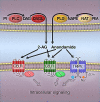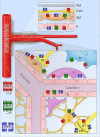Endocannabinoids in cerebrovascular regulation
- PMID: 26825517
- PMCID: PMC4865067
- DOI: 10.1152/ajpheart.00571.2015
Endocannabinoids in cerebrovascular regulation
Abstract
The cerebral blood flow is tightly regulated by myogenic, endothelial, metabolic, and neural mechanisms under physiological conditions, and a large body of recent evidence indicates that inflammatory pathways have a major influence on the cerebral blood perfusion in certain central nervous system disorders, like hemorrhagic and ischemic stroke, traumatic brain injury, and vascular dementia. All major cell types involved in cerebrovascular control pathways (i.e., smooth muscle, endothelium, neurons, astrocytes, pericytes, microglia, and leukocytes) are capable of synthesizing endocannabinoids and/or express some or several of their target proteins [i.e., the cannabinoid 1 and 2 (CB1 and CB2) receptors and the transient receptor potential vanilloid type 1 ion channel]. Therefore, the endocannabinoid system may importantly modulate the regulation of cerebral circulation under physiological and pathophysiological conditions in a very complex manner. Experimental data accumulated since the late 1990s indicate that the direct effect of cannabinoids on cerebral vessels is vasodilation mediated, at least in part, by CB1 receptors. Cannabinoid-induced cerebrovascular relaxation involves both a direct inhibition of smooth muscle contractility and a release of vasodilator mediator(s) from the endothelium. However, under stress conditions (e.g., in conscious restrained animals or during hypoxia and hypercapnia), cannabinoid receptor activation was shown to induce a reduction of the cerebral blood flow, probably via inhibition of the electrical and/or metabolic activity of neurons. Finally, in certain cerebrovascular pathologies (e.g., subarachnoid hemorrhage, as well as traumatic and ischemic brain injury), activation of CB2 (and probably yet unidentified non-CB1/non-CB2) receptors appear to improve the blood perfusion of the brain via attenuating vascular inflammation.
Keywords: TRPV1 channel; cannabinoid receptors; cerebral circulation; endocannabinoids; neurovascular unit.
Figures



References
-
- Adeva MM, Souto G, Donapetry C, Portals M, Rodriguez A, Lamas D. Brain edema in diseases of different etiology. Neurochem Int 61: 166–174, 2012. - PubMed
-
- Althoff TF, Offermanns S. G-protein-mediated signaling in vascular smooth muscle cells–implications for vascular disease. J Mol Med 93: 973–981, 2015. - PubMed
-
- Amenta PS, Jallo JI, Tuma RF, Elliott MB. A cannabinoid type 2 receptor agonist attenuates blood-brain barrier damage and neurodegeneration in a murine model of traumatic brain injury. J Neurosci Res 90: 2293–2305, 2012. - PubMed
-
- Ashton JC, Appleton I, Darlington CL, Smith PF. Immunohistochemical localization of cerebrovascular cannabinoid CB1 receptor protein. J Cardiovasc Pharmacol 44: 517–519, 2004. - PubMed
Publication types
MeSH terms
Substances
Grants and funding
LinkOut - more resources
Full Text Sources
Other Literature Sources

